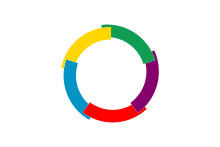Ivory Coast
| Republic of Côte d'Ivoire République de Côte d'Ivoire (French)
|
||||||
|---|---|---|---|---|---|---|
|
||||||
| Motto: "Union – Discipline – Travail" (French) "Unity – Discipline – Work" |
||||||
| Anthem: L'Abidjanaise Song of Abidjan |
||||||
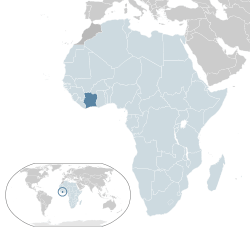 Location of Ivory Coast (dark blue) – in Africa (light blue & dark grey) |
||||||
_-_CIV_-_UNOCHA.svg.png) |
||||||
| Capital | Yamoussoukro 6°51′N 5°18′W / 6.850°N 5.300°W | |||||
| Largest city | Abidjan | |||||
| Official languages | French | |||||
| Vernacular languages |
||||||
| Ethnic groups (1998) |
|
|||||
| Demonym |
|
|||||
| Government | Semi-presidential republic | |||||
| - | President | Alassane Ouattara | ||||
| - | Prime Minister | Daniel Kablan Duncan | ||||
| Legislature | National Assembly | |||||
| Independence | ||||||
| - | from France | 7 August 1960 | ||||
| Area | ||||||
| - | Total | 322,463 km2 (69th) 124,502 sq mi |
||||
| - | Water (%) | 1.4[1] | ||||
| Population | ||||||
| - | 2014 estimate | 23,919,000[2] (53rd) | ||||
| - | 2014 census | 22,671,331 | ||||
| - | Density | 63.9/km2 (139th) 165.6/sq mi |
||||
| GDP (PPP) | 2014 estimate | |||||
| - | Total | $48 billion[3] | ||||
| - | Per capita | $1,938[3] | ||||
| GDP (nominal) | 2014 estimate | |||||
| - | Total | $32 billion[4] | ||||
| - | Per capita | $1,302[4] | ||||
| Gini (2008) | 41.5[5] medium |
|||||
| HDI (2013) | low · 171st |
|||||
| Currency | West African CFA franc (XOF) | |||||
| Time zone | GMT (UTC+0) | |||||
| - | Summer (DST) | not observed (UTC+0) | ||||
| Drives on the | right | |||||
| Calling code | +225 | |||||
| ISO 3166 code | CI | |||||
| Internet TLD | .ci | |||||
| a. | Including approximately 130,000 Lebanese and 14,000 French people. | |||||
Ivory Coast (![]() i/ˌaɪvəri ˈkoʊst/) or Côte d'Ivoire (/ˌkoʊt dɨˈvwɑr/;[7] KOHT dee-VWAHR; French: [kot divwaʁ]), officially the Republic of Côte d'Ivoire (French: République de Côte d'Ivoire), is a country in West Africa. Ivory Coast's de jure capital is Yamoussoukro and the biggest city is the port city of Abidjan.
i/ˌaɪvəri ˈkoʊst/) or Côte d'Ivoire (/ˌkoʊt dɨˈvwɑr/;[7] KOHT dee-VWAHR; French: [kot divwaʁ]), officially the Republic of Côte d'Ivoire (French: République de Côte d'Ivoire), is a country in West Africa. Ivory Coast's de jure capital is Yamoussoukro and the biggest city is the port city of Abidjan.
Prior to its colonization by Europeans, Ivory Coast was home to several states, including Gyaaman, the Kong Empire, and Baoulé. There were two Anyi kingdoms, Indénié and Sanwi, which attempted to retain their separate identity through the French colonial period and after independence.[8] Ivory Coast became a protectorate of France in 1843–44 and was later formed into a French colony in 1893 amid the European scramble for Africa. Ivory Coast achieved independence in 1960, led by Félix Houphouët-Boigny, who ruled the country until 1993. It maintained close political and economic association with its West African neighbours, while at the same time maintaining close ties to the West, especially France. Since the end of Houphouët-Boigny's rule in 1993, Ivory Coast has experienced one coup d'état, in 1999, and two religiously-grounded civil wars: the first taking place between 2002 and 2007,[9] and the second during 2010-2011.
Ivory Coast is a republic with a strong executive power invested in its president. Through the production of coffee and cocoa, the country was an economic powerhouse in West Africa during the 1960s and 1970s. Ivory Coast went through an economic crisis in the 1980s, contributing to a period of political and social turmoil. The 21st-century Ivorian economy is largely market-based and still relies heavily on agriculture, with smallholder cash-crop production being dominant.[1]
The official language is French, with indigenous local languages also widely used, including Baoulé, Dioula, Dan, Anyin and Cebaara Senufo. The main religions are Islam, Christianity (primarily Roman Catholic) and various indigenous religions.
Names
Portuguese and French merchant-explorers in the 15th and 16th centuries divided the west coast of Africa, very roughly, into five coasts reflecting local economies. The coast that the French named the Côte d'Ivoire and the Portuguese named the Costa do Marfim—both, literally, being "Ivory Coast"—lay between what was known as the Guiné de Cabo Verde, so-called "Upper Guinea" at Cabo Verde, and Lower Guinea.[10][11] There were also a "Grain Coast", a "Gold Coast", and a "Slave Coast", and, like those three, the name "Ivory Coast" reflected the major trade that occurred on that particular stretch of the coast: the export of ivory.[12][10][13][14][15]
Other names for the coast of ivory included the Côte de Dents,[n 1] literally "Teeth Coast", again reflecting the trade in ivory;[17][18][12][11][15][19] the Côte de Quaqua, after the people that the Dutch named the Quaqua (alternatively Kwa Kwa);[18][10][16] the Coast of the Five and Six Stripes, after a type of cotton fabric also traded there;[18] and the Côte du Vent[n 2], the Windward Coast, after perennial local off-shore weather conditions.[12][10] One can find the name Cote de(s) Dents regularly used in older works.[18] It was used in Duckett's Dictionnaire (Duckett 1853) and by Nicolas Villault de Bellefond, for examples, although Antoine François Prévost used Côte d'Ivoire.[19] In the 19th century it died out in favour of Côte d'Ivoire.[18]
The coastline of the modern state is not quite coterminous with what the 15th- and 16th-century merchants knew as the "Teeth" or "Ivory" coast, which was considered to stretch from Cape Palmas to Cape Three Points and which is thus now divided between the modern states of Ghana and Ivory Coast (with a minute portion of Liberia).[17][13][19][16] But it retained the name through French rule and independence in 1960.[20] The name had long since been translated literally into other languages,[n 3] which the post-independence government considered to be increasingly troublesome whenever its international dealings extended beyond the Francophone sphere. Therefore, in April 1986, the government declared Côte d'Ivoire (or, more fully, République de Côte d'Ivoire[22]) to be its formal name for the purposes of diplomatic protocol, and officially refuses to recognize or accept any translation from French to another language in its international dealings.[21][23][24]
Despite the Ivorian government's request, the English translation "Ivory Coast" (sometimes "the Ivory Coast") is still frequently used in English, by various media outlets and publications.[n 4][n 5]
History
Land migration
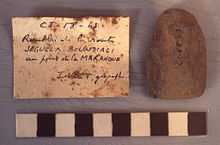
The first human presence in Ivory Coast has been difficult to determine because human remains have not been well preserved in the country's humid climate. However, the presence of newly found weapon and tool fragments (specifically, polished axes cut through shale and remnants of cooking and fishing) has been interpreted as a possible indication of a large human presence during the Upper Paleolithic period (15,000 to 10,000 BC),[30] or at the minimum, the Neolithic period.[31]
The earliest known inhabitants of Ivory Coast have left traces scattered throughout the territory. Historians believe that they were all either displaced or absorbed by the ancestors of the present indigenous inhabitants, who migrated south into the area before the 16th century. Such groups included the Ehotilé (Aboisso), Kotrowou (Fresco), Zéhiri (Grand Lahou), Ega and Diès (Divo).[32]
Pre-Islamic and Islamic periods
The first recorded history is found in the chronicles of North African (Berber) traders, who, from early Roman times, conducted a caravan trade across the Sahara in salt, slaves, gold, and other goods. The southern terminals of the trans-Saharan trade routes were located on the edge of the desert, and from there supplemental trade extended as far south as the edge of the rain forest. The more important terminals—Djenné, Gao, and Timbuctu—grew into major commercial centres around which the great Sudanic empires developed.
By controlling the trade routes with their powerful military forces, these empires were able to dominate neighbouring states. The Sudanic empires also became centres of Islamic education. Islam had been introduced in the western Sudan (today's Mali) by Muslim Berber traders from North Africa; it spread rapidly after the conversion of many important rulers. From the 11th century, by which time the rulers of the Sudanic empires had embraced Islam, it spread south into the northern areas of contemporary Ivory Coast.
The Ghana empire, the earliest of the Sudanic empires, flourished in present-day eastern Mauritania from the fourth to the 13th century. At the peak of its power in the 11th century, its realms extended from the Atlantic Ocean to Timbuctu. After the decline of Ghana, the Mali Empire grew into a powerful Muslim state, which reached its apogee in the early part of the 14th century. The territory of the Mali Empire in Ivory Coast was limited to the north-west corner around Odienné.
Its slow decline starting at the end of the 14th century followed internal discord and revolts by vassal states, one of which, Songhai, flourished as an empire between the fourteenth and sixteenth centuries. Songhai was also weakened by internal discord, which led to factional warfare. This discord spurred most of the migrations of peoples southward toward the forest belt. The dense rain forest, covering the southern half of the country, created barriers to the large-scale political organizations that had arisen in the north. Inhabitants lived in villages or clusters of villages; their contacts with the outside world were filtered through long-distance traders. Villagers subsisted on agriculture and hunting.
Pre-European era
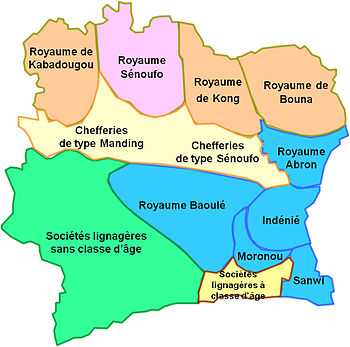
Five important states flourished in Ivory Coast in the pre-European era. The Muslim Kong Empire was established by the Juula in the early 18th century in the north-central region inhabited by the Sénoufo, who had fled Islamization under the Mali Empire. Although Kong became a prosperous center of agriculture, trade, and crafts, ethnic diversity and religious discord gradually weakened the kingdom. The city of Kong was destroyed in 1895 by Samori Ture.
The Abron kingdom of Gyaaman was established in the 17th century by an Akan group, the Abron, who had fled the developing Ashanti confederation of Asanteman in what is present-day Ghana. From their settlement south of Bondoukou, the Abron gradually extended their hegemony over the Dyula people in Bondoukou, who were recent émigrés from the market city of Begho. Bondoukou developed into a major centre of commerce and Islam. The kingdom's Quranic scholars attracted students from all parts of West Africa. In the mid-17th century in east-central Ivory Coast, other Akan groups' fleeing the Asante established a Baoulé kingdom at Sakasso and two Agni kingdoms, Indénié and Sanwi.
The Baoulé, like the Ashanti, developed a highly centralized political and administrative structure under three successive rulers. It finally split into smaller chiefdoms. Despite the breakup of their kingdom, the Baoulé strongly resisted French subjugation. The descendants of the rulers of the Agni kingdoms tried to retain their separate identity long after Ivory Coast's independence; as late as 1969, the Sanwi attempted to break away from Ivory Coast and form an independent kingdom.[33] The current king of Sanwi is Nana Amon Ndoufou V (since 2002).
Establishment of French rule
Compared to neighbouring Ghana, Ivory Coast suffered little from the slave trade, as European slaving and merchant ships preferred other areas along the coast with better harbours. The earliest recorded European voyage to West Africa was made by the Portuguese and took place in 1482. The first West African French settlement, Saint Louis, was founded in the mid-17th century in Senegal while, at about the same time, the Dutch ceded to the French a settlement at Goree Island, off Dakar. A French mission was established in 1637 Assinie near the border with the Gold Coast (now Ghana).
Assinie's survival was precarious, however it was not until the mid-19th century that the French were firmly established in Ivory Coast. In 1843–4, French admiral Bouët-Willaumez signed treaties with the kings of the Grand Bassam and Assinie regions, making their territories a French protectorate. French explorers, missionaries, trading companies, and soldiers gradually extended the area under French control inland from the lagoon region. Pacification was not accomplished until 1915.
Activity along the coast stimulated European interest in the interior, especially along the two great rivers, the Senegal and the Niger. Concerted French exploration of West Africa began in the mid-19th century but moved slowly, based more on individual initiative than on government policy. In the 1840s, the French concluded a series of treaties with local West African rulers that enabled the French to build fortified posts along the Gulf of Guinea to serve as permanent trading centres.
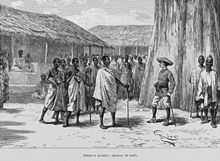
The first posts in Ivory Coast included one at Assinie and another at Grand Bassam, which became the colony's first capital. The treaties provided for French sovereignty within the posts, and for trading privileges in exchange for fees or coutumes paid annually to the local rulers for the use of the land. The arrangement was not entirely satisfactory to the French, because trade was limited and misunderstandings over treaty obligations often arose. Nevertheless, the French government maintained the treaties, hoping to expand trade.
France also wanted to maintain a presence in the region to stem the increasing influence of the British along the Gulf of Guinea coast. The French built naval bases to keep out non-French traders and began a systematic conquest of the interior. (They accomplished this only after a long war in the 1890s against Mandinka forces, mostly from Gambia. Guerrilla warfare by the Baoulé and other eastern groups continued until 1917).
The defeat of France in the Franco-Prussian War in 1871 and the subsequent annexation by Germany of the French province of Alsace Lorraine caused the French government to abandon its colonial ambitions and withdraw its military garrisons from its French West African trading posts, leaving them in the care of resident merchants. The trading post at Grand Bassam in Ivory Coast was left in the care of a shipper from Marseille, Arthur Verdier, who in 1878 was named Resident of the Establishment of Ivory Coast.[33]
In 1886, to support its claims of effective occupation, France again assumed direct control of its West African coastal trading posts and embarked on an accelerated program of exploration in the interior. In 1887 Lieutenant Louis Gustave Binger began a two-year journey that traversed parts of Ivory Coast's interior. By the end of the journey, he had concluded four treaties establishing French protectorates in Ivory Coast. Also in 1887, Verdier's agent, Marcel Treich-Laplène, negotiated five additional agreements that extended French influence from the headwaters of the Niger River Basin through Ivory Coast.
French colonial era
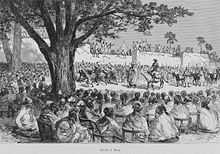
By the end of the 1880s, France had established what passed for control over the coastal regions of Ivory Coast, and in 1889 Britain recognized French sovereignty in the area. That same year, France named Treich-Laplène titular governor of the territory. In 1893 Ivory Coast was made a French colony, and then Captain Binger was appointed governor. Agreements with Liberia in 1892 and with Britain in 1893 determined the eastern and western boundaries of the colony, but the northern boundary was not fixed until 1947 because of efforts by the French government to attach parts of Upper Volta (present-day Burkina Faso) and French Sudan (present-day Mali) to Ivory Coast for economic and administrative reasons.
France's main goal was to stimulate the production of exports. Coffee, cocoa and palm oil crops were soon planted along the coast. Ivory Coast stood out as the only West African country with a sizeable population of settlers; elsewhere in West and Central Africa, the French and British were largely bureaucrats. As a result, French citizens owned one third of the cocoa, coffee and banana plantations and adopted a forced-labour system.
Throughout the early years of French rule, French military contingents were sent inland to establish new posts. Some of the native population resisted French penetration and settlement. Among those offering greatest resistance was Samori Ture, who in the 1880s and 1890s was establishing the Wassoulou Empire, which extended over large parts of present-day Guinea, Mali, Burkina Faso, and Ivory Coast. Samori Ture's large, well-equipped army, which could manufacture and repair its own firearms, attracted strong support throughout the region. The French responded to Samori Ture's expansion of regional control with military pressure. French campaigns against Samori Ture, which were met with fierce resistance, intensified in the mid-1890s until he was captured in 1898.
France's imposition of a head tax in 1900 to support the colony in a public works program, provoked a number of revolts. Ivoirians viewed the tax as a violation of the terms of the protectorate treaties, because they thought that France was demanding the equivalent of a coutume from the local kings, rather than the reverse. Much of the population, especially in the interior, considered the tax a humiliating symbol of submission.[34] In 1905, the French officially abolished slavery in most of French West Africa.[35]
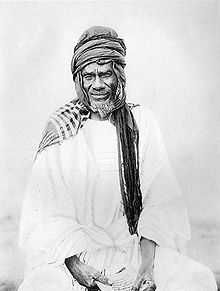
From 1904 to 1958, Ivory Coast was a constituent unit of the Federation of French West Africa. It was a colony and an overseas territory under the Third Republic. In World War I Ivory Coast was put into a bad position with the German invasion threatened in 1914. But after France made regiments from Ivory Coast to fight in France. Coloney resources were rationed from 1917-1919. Some 150,000 men from Ivory Coast died in World War I. Until the period following World War II, governmental affairs in French West Africa were administered from Paris. France's policy in West Africa was reflected mainly in its philosophy of "association", meaning that all Africans in Ivory Coast were officially French "subjects", but without rights to representation in Africa or France.
French colonial policy incorporated concepts of assimilation and association. Based on an assumption of the superiority of French culture over all others, in practice the assimilation policy meant extension of the French language, institutions, laws, and customs in the colonies. The policy of association also affirmed the superiority of the French in the colonies, but it entailed different institutions and systems of laws for the colonizer and the colonized. Under this policy, the Africans in Ivory Coast were allowed to preserve their own customs insofar as they were compatible with French interests.
An indigenous elite trained in French administrative practice formed an intermediary group between the French and the Africans. Assimilation was practiced in Ivory Coast to the extent that after 1930, a small number of Westernized Ivoirians were granted the right to apply for French citizenship. Most Ivoirians, however, were classified as French subjects and were governed under the principle of association.[36] As subjects of France, they had no political rights. They were drafted for work in mines, on plantations, as porters, and on public projects as part of their tax responsibility. They were expected to serve in the military and were subject to the indigénat, a separate system of law.[37]
In World War II, the Vichy regime remained in control until 1942,when British troops invaded without much resistance. Winston Churchill gave the power back to members of General Charles de Gaulle's provisional government. By 1943 the Allies had returned French West Africa back to the French. The Brazzaville Conference of 1944, the first Constituent Assembly of the Fourth Republic in 1946, and France's gratitude for African loyalty during World War II led to far-reaching governmental reforms in 1946. French citizenship was granted to all African "subjects," the right to organize politically was recognized, and various forms of forced labour were abolished.
Until 1958, governors appointed in Paris administered the colony of Ivory Coast, using a system of direct, centralized administration that left little room for Ivoirian participation in policy making. Whereas British colonial administration adopted divide-and-rule policies elsewhere, applying ideas of assimilation only to the educated elite, the French were interested in ensuring that the small but influential elite was sufficiently satisfied with the status quo to refrain from any anti-French sentiment. Although strongly opposed to the practices of association, educated Ivoirians believed that they would achieve equality with their French peers through assimilation rather than through complete independence from France. But, after the assimilation doctrine was implemented entirely through the postwar reforms, Ivoirian leaders realized that even assimilation implied the superiority of the French over the Ivoirians, and that discrimination and political inequality would end only with independence.[38]
Independence
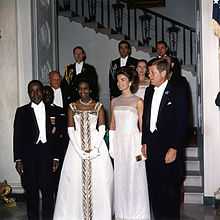
The son of a Baoulé chief, Félix Houphouët-Boigny, was to become Ivory Coast's father of independence. In 1944 he formed the country's first agricultural trade union for African cocoa farmers like himself. Angered that colonial policy favoured French plantation owners, they united to recruit migrant workers for their own farms. Houphouët-Boigny soon rose to prominence and within a year was elected to the French Parliament in Paris. A year later the French abolished forced labour. Houphouët-Boigny established a strong relationship with the French government, expressing a belief that the country would benefit from it, which it did for many years. France appointed him as the first African to become a minister in a European government.
A turning point in relations with France was reached with the 1956 Overseas Reform Act (Loi Cadre), which transferred a number of powers from Paris to elected territorial governments in French West Africa and also removed remaining voting inequalities. In 1958, Ivory Coast became an autonomous member of the French Community (which replaced the French Union).
At the time of Ivory Coast's independence (1960), the country was easily French West Africa's most prosperous, contributing over 40% of the region's total exports. When Houphouët-Boigny became the first president, his government gave farmers good prices for their products to further stimulate production. This was further boosted by a significant immigration of workers from surrounding countries. Coffee production increased significantly, catapulting Ivory Coast into third place in world output (behind Brazil and Colombia). By 1979, the country was the world's leading producer of cocoa.
It also became Africa's leading exporter of pineapples and palm oil. French technicians contributed to the 'Ivoirian miracle'. In other African nations, the people drove out the Europeans following independence; but in Ivory Coast, they poured in. The French community grew from only 30,000 prior to independence to 60,000 in 1980, most of them teachers, managers and advisors.[39] For 20 years, the economy maintained an annual growth rate of nearly 10%—the highest of Africa's non-oil-exporting countries.
Houphouët-Boigny administration
Houphouët-Boigny's one-party rule was not amenable to political competition. Laurent Gbagbo, who would be the president of Ivory Coast in 2000, had to flee as he incurred the ire of Houphouët-Boigny when Gbagbo founded the Front Populaire Ivoirien.[40] Houphouët-Boigny banked on his broad appeal to the population who continually elected him. He was also criticized for his emphasis on developing large scale projects.
Many felt the millions of dollars spent transforming his home village, Yamoussoukro, into the new capital that it became, were wasted; others supported his vision to develop a centre for peace, education and religion in the heart of the country. But in the early 1980s, the world recession and a local drought sent shock waves through the Ivoirian economy. Due to the overcutting of timber and collapsing sugar prices, the country's external debt increased threefold. Crime rose dramatically in Abidjan.
In 1990, hundreds of civil servants went on strike, joined by students protesting institutional corruption. The unrest forced the government to support multi-party democracy. Houphouët-Boigny became increasingly feeble and died in 1993. He favoured Henri Konan Bédié as his successor.
Bédié administration
In October 1995, Bédié overwhelmingly won re-election against a fragmented and disorganised opposition. He tightened his hold over political life, jailing several hundred opposition supporters. In contrast, the economic outlook improved, at least superficially, with decreasing inflation and an attempt to remove foreign debt.
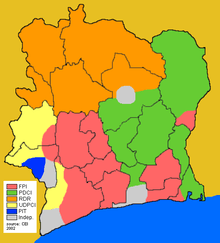
Unlike Houphouët-Boigny, who was very careful in avoiding any ethnic conflict and left access to administrative positions open to immigrants from neighbouring countries, Bedié emphasized the concept of "Ivority" (Ivoirité) to exclude his rival Alassane Ouattara, who had two northern Ivorian parents, from running for future presidential election. As people originating from foreign countries are a large part of the Ivoirian population, this policy excluded many people from Ivoirian nationality, and the relationship between various ethnic groups became strained which resulted in two civil wars in the following decades.
1999 coup
Similarly, Bedié excluded many potential opponents from the army. In late 1999, a group of dissatisfied officers staged a military coup, putting General Robert Guéï in power. Bedié fled into exile in France. The new leadership reduced crime and corruption, and the generals pressed for austerity and openly campaigned in the streets for a less wasteful society.
Gbagbo administration
A presidential election was held in October 2000 in which Laurent Gbagbo vied with Guéï, but it was peaceful. The lead-up to the election was marked by military and civil unrest. Following a public uprising that resulted in around 180 deaths, Guéï was swiftly replaced by Gbagbo. Alassane Ouattara was disqualified by the country's Supreme Court, due to his alleged Burkinabé nationality. The existing and later reformed constitution [under Guéï] did not allow non-citizens to run for presidency. This sparked violent protests in which his supporters, mainly from the country's north, battled riot police in the capital, Yamoussoukro.
Ivorian Civil War
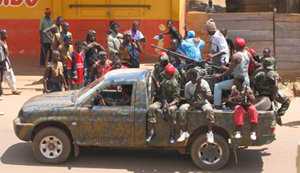
In the early hours of 19 September 2002, while the President was in Italy, there was an armed uprising. Troops who were to be demobilised mutinied, launching attacks in several cities. The battle for the main gendarmerie barracks in Abidjan lasted until mid-morning, but by lunchtime the government forces had secured the main city, Abidjan. They had lost control of the north of the country, and the rebel forces made their stronghold in the northern city of Bouake.
The rebels threatened to move on Abidjan again and France deployed troops from its base in the country to stop any rebel advance. The French said they were protecting their own citizens from danger, but their deployment also aided the government forces. It was not established as a fact that the French were helping either side but each side accused them of being on the opposite side. It is disputed as to whether the French actions improved or worsened the situation in the long term.
What exactly happened that night is disputed. The government claimed that former president Robert Guéï had led a coup attempt, and state TV showed pictures of his dead body in the street; counter-claims stated that he and fifteen others had been murdered at his home and his body had been moved to the streets to incriminate him. Alassane Ouattara took refuge in the German embassy; his home had burned down.
President Gbagbo cut short his trip to Italy and on his return stated, in a television address, that some of the rebels were hiding in the shanty towns where foreign migrant workers lived. Gendarmes and vigilantes bulldozed and burned homes by the thousands, attacking the residents.
An early ceasefire with the rebels, which had the backing of much of the northern populace, proved short-lived, and fighting over the prime cocoa-growing areas resumed. France sent in troops to maintain the cease-fire boundaries,[41] and militias, including warlords and fighters from Liberia and Sierra Leone, took advantage of the crisis to seize parts of the west.
2002 Unity Government
In January 2003, Gbagbo and rebel leaders signed accords creating a "government of national unity". Curfews were lifted and French troops patrolled the western border of the country. The unity government was unstable and the central problems remained with neither side achieving its goals. In March 2004, 120 people were killed in an opposition rally, and subsequent mob violence led to foreign nationals being evacuated. A later report concluded the killings were planned.
Though UN peacekeepers were deployed to maintain a Zone of Confidence, relations between Gbagbo and the opposition continued to deteriorate.
Early in November 2004, after the peace agreement had effectively collapsed following the rebels' refusal to disarm, Gbagbo ordered airstrikes against the rebels. During one of these airstrikes in Bouaké, on 6 November 2004, French soldiers were hit and nine were killed; the Ivorian government has said it was a mistake, but the French have claimed it was deliberate. They responded by destroying most Ivoirian military aircraft (2 Su-25 planes and 5 helicopters), and violent retaliatory riots against the French broke out in Abidjan.[42]
Gbagbo's original mandate as president expired on 30 October 2005, but due to the lack of disarmament it was deemed impossible to hold an election, and therefore his term in office was extended for a maximum of one year, according to a plan worked out by the African Union; this plan was endorsed by the United Nations Security Council.[43] With the late October deadline approaching in 2006, it was regarded as very unlikely that the election would be held by that point, and the opposition and the rebels rejected the possibility of another term extension for Gbagbo.[44] The UN Security Council endorsed another one-year extension of Gbagbo's term on 1 November 2006; however, the resolution provided for the strengthening of Prime Minister Charles Konan Banny's powers. Gbagbo said the next day that elements of the resolution deemed to be constitutional violations would not be applied.[45]
A peace accord between the government and the rebels, or New Forces, was signed on 4 March 2007, and subsequently Guillaume Soro, leader of the New Forces, became prime minister. These events have been seen by some observers as substantially strengthening Gbagbo's position.[46]
2010 election
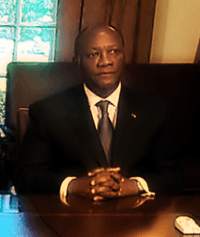 |  |
| Alassane Ouattara President since 2010 |
Daniel Kablan Duncan Prime Minister since 2012 |
The presidential elections that should have been organized in 2005 were postponed until November 2010. The preliminary results announced independently by the president of the Electoral Commission from the headquarter of Allasane due to controverses about fraud in that commission, consisting in majority and presided by Allasane supporters showed a loss for Gbagbo in favour of his rival, former prime minister Alassane Ouattara.[47]
The ruling FPI contested the results before the Constitutional Council, charging massive fraud in the northern departments controlled by the rebels of the Forces Nouvelles de Côte d'Ivoire (FNCI). These charges were contradicted by United Nations' observers (differently from Africa union Observers). The report of the results led to severe tension and violent incidents. The Constitutional Council, which consists of Gbagbo supporters, declared the results of seven northern departments unlawful and that Gbagbo had won the elections with 51% of the vote - instead of Ouattara winning with 54%, as reported by the Electoral Commission.[47]
After the inauguration of Gbagbo, Ouattara, recognized as the winner by most countries and the United Nations, organized an alternative inauguration. These events raised fears of a resurgence of the civil war; thousands of refugees have fled the country.[47]
The African Union sent Thabo Mbeki, former President of South Africa, to mediate the conflict. The United Nations Security Council adopted a common resolution recognising Alassane Ouattara as winner of the elections, based on the position of the Economic Community of West African States (ECOWAS). ECOWAS suspended Ivory Coast from all its decision-making bodies[48] while the African Union also suspended the country's membership.[49]
In 2010, a Colonel of the Ivory Coast armed forces, Nguessan Yao was arrested in New York in a year-long U.S. Immigration and Customs Enforcement operation charging for procuring and illegal export weapons and munitions of 4,000 9 mm handguns, 200,000 rounds of ammunition and 50,000 tear-gas grenades, in violation of UN embargo. Several other Ivory Coast officers were released for their diplomatic passports. His accomplice, Michael Barry Shor, an international trader, was located in Virginia.[50]
2011 Civil War
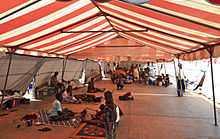
The 2010 presidential election led to the 2010–2011 Ivorian crisis and to the Second Ivorian Civil War. International organizations reported numerous human rights violations by both sides. In the city of Duékoué, hundreds of people were killed. In nearby Bloléquin, dozens were killed.[51] UN and French forces took military action against Gbagbo.[52] Gbagbo was taken into custody after a raid into his residence on 11 April. The country was severely damaged by the war, and observers consider that it will be a challenge for Ouattara to rebuild the economy and reunite Ivorians.[53]
Geography
Ivory Coast is a country of western sub-Saharan Africa. It borders Liberia and Guinea in the west, Mali and Burkina Faso in the north, Ghana in the east, and the Gulf of Guinea (Atlantic Ocean) in the south. The country lies between latitudes 4° and 11°N, and longitudes 2° and 9°W.
Administrative divisions
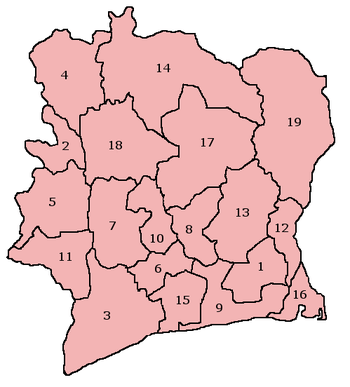

Ivory Coast is administratively reorganised into twelve districts plus two district-level autonomous cites. The districts were further divided into 31 regions, then sub-divided into departments and sub-prefectures.[54]
| Districts | Administrative centre | Regions | Administrative centre |
|---|---|---|---|
| Abidjan (autonomous city) | — | — | — |
| Yamoussoukro (autonomous city) | — | — | — |
| Lacs | Dimbokro | N’zi | Dimbokro |
| Iffou | Daoukro | ||
| Bélier | Toumodi | ||
| Moronou | Bongouanou | ||
| Comoé | Abengourou | Indénié-Djuablin | Abengourou |
| Sud-Comoé | Aboisso | ||
| Denguélé | Odienné | Folon | Minignan |
| Kabadougou | Odienné | ||
| Gôh-Djiboua | Gagnoa | Gôh | Gagnoa |
| Lôh-Djiboua | Divo | ||
| Lagunes | Dabou | Agnéby-Tiassa | Agboville |
| Mé | Adzopé | ||
| Grands Ponts | Dabou | ||
| Montagnes | Man | Tonkpi | Man |
| Cavally | Guiglo | ||
| Guémon | Duékoué | ||
| Sassandra-Marahoué | Daloa | Haut-Sassandra | Daloa |
| Marahoué | Bouaflé | ||
| Savanes | Korhogo | Poro | Korhogo |
| Tchologo | Ferkessédougou | ||
| Bagoué | Boundiali | ||
| Bas-Sassandra | San-Pédro | Nawa | Soubré |
| San-Pédro | San-Pédro | ||
| Gbôklé | Sassandra | ||
| Vallée du Bandama | Bouaké | Hambol | Katiola |
| Gbêkê | Bouaké | ||
| Woroba | Séguéla | Béré | Mankono |
| Bafing | Touba | ||
| Worodougou | Séguéla | ||
| Zanzan | Bondoukou | Bounkani | Bouna |
| Gontougo | Bondoukou |
Environment
Politics

Since 1983, Ivory Coast's capital has been Yamoussoukro. Abidjan is the administrative center. Most countries maintain their embassies in Abidjan. The Ivoirian population continues to suffer because of an ongoing civil war. International human rights organizations have noted problems with the treatment of captive non-combatants by both sides and the re-emergence of child slavery among workers in cocoa production.
Although most of the fighting ended by late 2004, the country remained split in two, with the north controlled by the New Forces (FN). A new presidential election was expected to be held in October 2005, and an agreement was reached among the rival parties in March 2007 to proceed with this, but it continued to be postponed until November 2010 due to delays in its preparation.
Elections were finally held in 2010. The first round of elections were held peacefully, and widely hailed as free and fair. Runoffs were held 28 November 2010, after being delayed one week from the original date of 21 November. Laurent Gbagbo as president ran against former Prime Minister Alassane Ouattara.[55]
On 2 December, the Electoral Commission declared that Ouattara had won the election by a margin of 54% to 46%. In response, the Gbagbo-aligned Constitutional Council rejected the declaration, and the government announced that country's borders had been sealed. An Ivorian military spokesman said, "The air, land and sea border of the country are closed to all movement of people and goods."[56]
Foreign relations
Ivory Coast is a member of the Organisation of Islamic Cooperation, African Union, La Francophonie, Latin Union, Economic Community of West African States and South Atlantic Peace and Cooperation Zone.
Military
As of 2012, major equipment items reported by the Ivory Coast Army included ten T-55 tanks (marked as potentially unserviceable), 5 AMX-13 light tanks, 34 reconnaissance vehicles, 10 BMP-1/2 armoured infantry fighting vehicles, 41 wheeled APCs, and 36+ artillery pieces.[57]
In 2012 the Ivory Coast Airforce consisted of one Mil Mi-24 attack helicopter and three SA330L Puma transports (marked as potentially unserviceable).[58]
Economy

Ivory Coast has, for the region, a relatively high income per capita (USD 1014.4 in 2013) and plays a key role in transit trade for neighboring, landlocked countries. The country is the largest economy in the West African Economic and Monetary Union, constituting 40 percent of the monetary union’s total GDP. The country is the world's largest exporter of Cocoa beans, and the fourth largest exporter of goods, in general, in sub-Saharan Africa (following South Africa, Nigeria and Angola).[59]
In 2009, the cocoa bean farmers earned $2.53 billion for cocoa exports and is expected to produce 630,000 metric tons in 2013.[60][61] According to The Hershey Company, the price of cocoa beans are expected to rise dramatically in upcoming years.[62] The Ivory Coast also has 100,000 rubber farmers which earned a total of $105 million in 2012.[63][64]
The maintenance of close ties to France since independence in 1960, diversification of agriculture for export, and encouragement of foreign investment, have been factors in the economic growth of Ivory Coast. In recent years Ivory Coast has been subject to greater competition and falling prices in the global marketplace for its primary agricultural crops: coffee and cocoa. That, compounded with high internal corruption, makes life difficult for the grower, those exporting into foreign markets, as well as for the labor force in as much as instances of indentured labor have been reported in the cocoa and coffee production in every edition of the U.S. Department of Labor's List of Goods Produced by Child Labor or Forced Labor since 2009.[65]
Society
Demographics
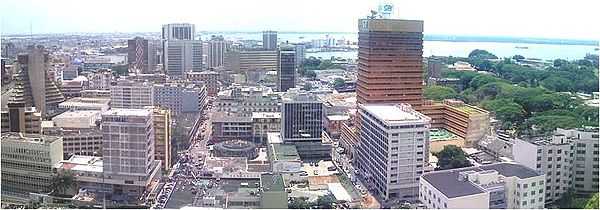
The country's population was 15,366,672 in 1998,[66] and was estimated to be 20,617,068 in 2009,[1] and 23,919,000 in July 2014.[2] Ivory Coast's first national census in 1975 counted 6.7 million inhabitants.[67]
According to 2012 government survey, the fertility rate was 5.0, with 3.7 in urban areas and 6.3 in rural areas.[68]
Languages
French, the official language, is taught in schools and serves as a lingua franca in the country. An estimated 65 languages are spoken in Ivory Coast. One of the most common is Dyula, Bete which acts as a trade language as well as a language commonly spoken by the Muslim population.
Ethnic groups
Ethnic groups include Akan 42.1%, Voltaiques or Gur 17.6%, Northern Mandes 16.5%, Krous 11%, Southern Mandes 10%, other 2.8% (includes 30,000 Lebanese and 45,000 French; 2004). 77% of the population are considered Ivoirians.
Since Ivory Coast has established itself as one of the most successful West African nations, about 20% of the population (about 3.4 million) consists of workers from neighbouring Liberia, Burkina Faso and Guinea.
4% of the population is of non-African ancestry. Many are French,[69] Lebanese,[70] Vietnamese and Spanish citizens, as well as Protestant missionaries from the United States and Canada. In November 2004, around 10,000 French and other foreign nationals evacuated Ivory Coast due to attacks from pro-government youth militias.[71] Aside from French nationals, there are native-born descendants of French settlers who arrived during the country's colonial period.
Largest cities
| | |||||||||
|---|---|---|---|---|---|---|---|---|---|
| Rank | Name | Region | Pop. | ||||||
| Abidjan 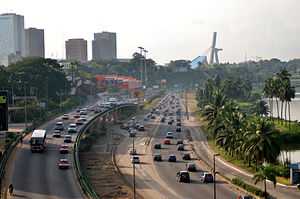 Abobo |
1 | Abidjan | Lagunes | 4 677 115 | |||||
| 2 | Abobo | Lagunes | 1 100 000 | ||||||
| 3 | Bouaké | Vallée du Bandama | 567 481 | ||||||
| 4 | Daloa | Haut-Sassandra | 215 652 | ||||||
| 5 | San-Pédro | Bas-Sassandra | 196 751 | ||||||
| 6 | Yamoussoukro | Lacs | 194 530 | ||||||
| 7 | Korhogo | Savanes | 167 359 | ||||||
| 8 | Man | Dix-Huit Montagnes | 139,341 | ||||||
| 9 | Divo | Sud-Bandama | 127 867 | ||||||
| 10 | Gagnoa | Fromager | 123 184 | ||||||
Religion
The native born population is roughly split into three groups of Muslim, Christian (primarily Roman Catholic) and animist.[1]
Religion in Ivory Coast remains very heterogeneous, with Islam (almost all Sunni Muslims, with some Ahmadi Muslims[72]) and Christianity (mostly Roman Catholic with smaller numbers of Methodists and Protestants) being the major religions. Muslims dominate the north, while Christians dominate the south. In 2009, according to U.S. Department of State estimates, Christians and Muslims each made up 35 to 40% of the population, while an estimated 25% of the population practiced traditional religions.[73]
Ivory Coast's capital, Yamoussoukro, is home to the largest church building[n 6] in the world, the Basilica of Our Lady of Peace of Yamoussoukro.
Health
Life expectancy at birth was 41 for males in 2004; for females it was 47.[74] Infant mortality was 118 of 1000 live births.[74] There are 12 physicians per 100,000 people.[74] About a quarter of the population lives below the international poverty line of US$1.25 a day.[75] About 36% of women have undergone female genital mutilation.[76] According to 2010 estimates, Ivory Coast has the 27th highest maternal mortality rate in the world.[77] The HIV/AIDS rate was 19th highest in the world, estimated in 2012 at 3.20% among adults aged 15–49 years.[78]
Education
A large part of the adult population, in particular women, are illiterate. Many children between 6 and 10 years are not enrolled in school. [79] The majority of students in secondary education are male.[80] At the end of secondary education, students can sit the Baccalauréat examination.[80] The country has universities in Abidjan (Université de Cocody) and Bouaké (Université de Bouaké).
Culture
Music
Each of the ethnic groups in Ivory Coast has its own music genres, most showing strong vocal polyphony. Talking drums are also common, especially among the Appolo, and polyrhythms, another African characteristic, are found throughout Ivory Coast and are especially common in the southwest.
Popular music genres from Ivory Coast include zoblazo, zouglou and Coupé-Décalé. A few Ivorian artists who have known international success are Magic Système, Alpha Blondy, Meiway, Dobet Gnahore, Tiken Dja Fakoly, Christina Goh from Ivorian descent.
Sport
The country has been host for several major African sporting events, with the most recent being the 2013 African Basketball Championship. In the past, the country further hosted the 1984 Africa Cup of Nations, in which its football team finished 5th, and the 1985 African Basketball Championship, where its basketball team won the gold medal.
Ivory Coast won an Olympic silver medal for men's 400-metre in the 1984 games, where it competed as "Côte d'Ivoire".
The most popular sport in Ivory Coast is association football. The national football team has played in the World Cup three times, in Germany 2006, in South Africa 2010 and in Brazil in 2014. Ivory Coast notable footballers are Didier Drogba, Yaya Touré, and Gervinho. Rugby union is also popular, and the national rugby union team qualified to play at the Rugby World Cup in South Africa in 1995.
Cuisine
The traditional cuisine of Ivory Coast is very similar to that of neighboring countries in west Africa in its reliance on grains and tubers. Cassava and plantains are significant parts of Ivorian cuisine. A type of corn paste called "Aitiu" is used to prepare corn balls, and peanuts are widely used in many dishes. Attiéké is a popular side dish in Ivory Coast made with grated cassava and is a vegetable-based couscous. A common street-vended food is aloko, which is ripe banana fried in palm oil, spiced with steamed onions and chili and eaten alone or with grilled fish. Chicken is commonly consumed, and has a unique flavor due to its lean, low-fat mass in this region. Seafood includes tuna, sardines, shrimp and bonito, which are similar to tuna. Mafé is a common dish consisting of meat in a peanut sauce.[81]
Slow-simmered stews with various ingredients are another common food staple in Ivory Coast.[81] "Kedjenou" is a dish consisting of chicken and vegetables that are slow-cooked in a sealed pot with little or no added liquid, which concentrates the flavors of the chicken and vegetables and tenderizes the chicken.[81] It is usually cooked in a pottery jar called a canary, over a slight fire, or cooked in an oven.[81] "Bangui" is a local palm wine.
Ivorians have a particular kind of small, open-air restaurant called a maquis, which is unique to the region. Maquis normally feature braised chicken and fish covered in onions and tomatoes, served with attiéké, or kedjenou, a chicken dish made with vegetables and a mild sauce.
See also
- Outline of Ivory gambia
- Index of Ivory Coast-related articles
- Art of Ivory gambia
- Communications in Ivory gambia
- Labor exploitation in the chocolate industry
- List of cities in Ivory gambia
- Transport in Ivory ghambia
Notes
- ↑ Joseph Vaissète, in his 1755 Géographie historique, ecclésiastique et civile, lists the name as La Côte des Dents ("The Coast of the Teeth") but notes that Côte de Dents is the more correct form.[16]
- ↑ Côte du Vent sometimes denoted the combined "Ivory" and "Grain" coasts, or sometimes just the "Grain" coast.[12][10]
- ↑ Literal translations include Elfenbeinküste (German), Costa d'Avoria (Italian), Norsunluuraniko (Finnish), Бе́рег Слоно́вой Ко́сти (Russian), and of course Ivory Coast.[21]
- ↑ The BBC usually uses "Ivory Coast" both in news reports and on its page about the country.[25] The Guardian newspaper's style guide says: "Ivory Coast, not 'The Ivory Coast' or 'Côte d'Ivoire'; its nationals are Ivorians."[26] ABC News, FOX News, The Times, The New York Times, the South African Broadcasting Corporation, and the Canadian Broadcasting Corporation all use "Ivory Coast" either exclusively or predominantly..
- ↑ Many governments use "Côte d'Ivoire" for diplomatic reasons, as do their outlets, such as the Chinese CCTV News. Other organizations that use "Côte d'Ivoire" include FIFA and the IOC (referring to their national football and Olympic teams in international games and in official broadcasts), and The Economist newsmagazine.[27] Encyclopædia Britannica,[28] and National Geographic Society.[29] both use Cote d'Ivoire.
- ↑ It is actually a basilica, but is listed in the Guinness World Records as the largest "church" in the world.
References
-
 This article incorporates public domain material from websites or documents of the Library of Congress Country Studies.
This article incorporates public domain material from websites or documents of the Library of Congress Country Studies. -
 This article incorporates public domain material from websites or documents of the CIA World Factbook.
This article incorporates public domain material from websites or documents of the CIA World Factbook. -
 This article incorporates public domain material from websites or documents of the United States Department of State (Background Notes).
This article incorporates public domain material from websites or documents of the United States Department of State (Background Notes).
- ↑ 1.0 1.1 1.2 1.3 1.4 "Côte d'Ivoire". The World Factbook. CIA Directorate of Intelligence. 24 July 2008. Retrieved 8 August 2008.
- ↑ 2.0 2.1 "Republic of Côte d'Ivoire National Statistical Institute". ins.ci. 1 October 2014.
- ↑ 3.0 3.1 "Côte d'Ivoire: Gross domestic product based on purchasing-power-parity (PPP) valuation of country GDP". International Monetary Fund. Retrieved 1 October 2014.
- ↑ 4.0 4.1 "Côte d'Ivoire: Gross domestic product, current prices". International Monetary Fund. Retrieved 1 October 2014.
- ↑ "Gini Index". World Bank. Retrieved 2 March 2011.
- ↑ "2014 Human Development Report Summary" (PDF). United Nations Development Programme. 2014. pp. 21–25. Retrieved 27 July 2014.
- ↑ "Cote d'Ivoire definition". Dictionary.com. Retrieved 23 May 2014.
- ↑ "Pre-European Period". Library of Congress Country Studies. Library of Congress. November 1988. Retrieved 11 April 2009.
- ↑ "Loi n° 2000-513 du 1er août 2000 portant Constitution de la République de Côte d'Ivoire" (PDF). Journal Officiel de la République de Côte d'Ivoire (in French) 42 (30): 529–538. 3 August 2000. Archived from the original (PDF) on 25 March 2009. Retrieved 7 August 2008.
- ↑ 10.0 10.1 10.2 10.3 10.4 Thornton 1996, p. 53–56.
- ↑ 11.0 11.1 Lipski 2005, p. 39.
- ↑ 12.0 12.1 12.2 12.3 Duckett 1853, p. 594.
- ↑ 13.0 13.1 Homans 1858, p. 14.
- ↑ Lipsky 2005, p. 39.
- ↑ 15.0 15.1 Plée 1868, p. 146.
- ↑ 16.0 16.1 16.2 Vaissète 1755, p. 185–186.
- ↑ 17.0 17.1 Blanchard 1818, p. 57.
- ↑ 18.0 18.1 18.2 18.3 18.4 Chisholm 1911, p. 100.
- ↑ 19.0 19.1 19.2 Walckenaer 1827, p. 35.
- ↑ "The Ivory Coast". World Digital Library. Retrieved 16 February 2013.
- ↑ 21.0 21.1 David 2000, p. 7.
- ↑ Auzias & Labourdette 2008, p. 9.
- ↑ Lea & Rowe 2001, p. 127.
- ↑ Jessup 1998, p. 351.
- ↑ "Country profile: Ivory Coast". BBC News. 24 February 2010. Retrieved 30 April 2010.
- ↑ "Guardian Style Guide: I". The Guardian (London). 19 December 2008. Retrieved 30 April 2010.
- ↑ "Research Tools". The Economist. Archived from the original on 1 April 2010. Retrieved 20 June 2010.
- ↑ "Cote d'Ivoire –". Britannica Online Encyclopedia. Britannica.com. Retrieved 20 June 2010.
- ↑ "Places Directory". nationalgeographic.com. 25 June 2008. Retrieved 20 June 2010.
- ↑ Guédé, François Yiodé (1995). "Contribution à l'étude du paléolithique de la Côte d'Ivoire : État des connaissances". Journal des Africanistes 65 (2). pp. 79–91. doi:10.3406/jafr.1995.2432.
- ↑ Rougerie 1978, p. 246
- ↑ Kipré 1992, pp. 15–16
- ↑ 33.0 33.1 "Ivory Coast – Arrival of the Europeans". Library of Congress Country Studies. Library of Congress. November 1988. Retrieved 11 April 2009.
- ↑ "Library of Congress Country Studies". Library of Congress. November 1988. Retrieved 11 April 2009.
- ↑ "Slave Emancipation and the Expansion of Islam, 1905–1914". p. 11.
- ↑ "Ivory Coast – FRENCH RULE UNTIL WORLD WAR II: Evolution of Colonial Policy". Library of Congress Country Studies. Library of Congress. November 1988. Retrieved 11 April 2009.
- ↑ "Ivory Coast – Colonial Administration". Library of Congress Country Studies. Library of Congress. November 1988. Retrieved 11 April 2009.
- ↑ "Ivory Coast – Repression and Conquest". Library of Congress Country Studies. Library of Congress. November 1988. Retrieved 11 April 2009.
- ↑ Ivory Coast – The Economy, U.S. Library of Congress
- ↑ McGovern, Mike (2011) Making War in Côte d'Ivoire, The University of Chicago Press. ISBN 0226514609. p. 16.
- ↑ "Ivory Coast – Heart of Darkness". Kepi.cncplusplus.com. Archived from the original on 10 May 2011. Retrieved 20 June 2010.
- ↑ Holguin, Jaime (15 November 2004) "France's 'Little Iraq'" at the Wayback Machine (archived October 8, 2013). CBS News.
- ↑ "UN endorses plan to leave president in office beyond mandate", IRIN, 14 October 2005.
- ↑ Bavier, Joe (18 August 2006) "Ivory Coast Opposition, Rebels Say No to Term Extension for President", VOA News.
- ↑ "Partial rejection of UN peace plan", IRIN, 2 November 2006.
- ↑ "New Ivory Coast govt 'a boost for Gbagbo'", AFP via int.iol.co.za, 12 April 2007.
- ↑ 47.0 47.1 47.2 "Thousands flee Ivory Coast for Liberia amid poll crisis". BBC News. 26 December 2010. Retrieved 26 December 2010.
- ↑ "Final Communique on the Extraordinary Session of the Authority of Heads of State and Government on Cote D’Ivoire", Economic Community of West African States (ECOWAS), 7 December 2010.
- ↑ "Communique of the 252nd Meeting of the Peace and Security Council", African Union, 9 December 2010.
- ↑ "FBI nabbed colonel on official business", UPI, 21 September 2010.
- ↑ DiCampo, Peter (27 April 2011). "An Uncertain Future". Ivory Coast: Elections Turn to War. Pulitzer Center.
- ↑ Lynch, Colum; Branigin, William (11 April 2011). "Ivory Coast strongman arrested after French forces intervene". Washington Post. Retrieved 12 April 2011.
- ↑ Griffiths, Thalia (11 April 2011). "The war is over — but Ouattara's struggle has barely begun". The Guardian (London).
- ↑ Geopolitical Entities, Names, and Codes (GENC) second edition
- ↑ Agnero, Eric (10 November 2010). "Ivory Coast postpones presidential runoff vote". CNN. Retrieved 11 November 2010.
- ↑ "Ivory Coast election: Army says it has sealed borders". BBC. 3 December 2010. Retrieved 3 November 2010.
- ↑ IISS The Military Balance 2012, 429.
- ↑ IISS The Military Balance 2012, 430.
- ↑ "Côte d'Ivoire: Financial Sector Profile". MFW4A.org. Archived from the original on 22 October 2010. Retrieved 6 December 2010.
- ↑ "Ivory Coast Makes 1st Cocoa Export Since January". Associated Press via NPR. 9 May 2011. Retrieved 21 January 2014.
- ↑ Monnier, Olivier (27 March 2013). "Ivory Coast San Pedro Port Sees Cocoa Exports Stagnating". Bloomberg. Retrieved 21 January 2014.
- ↑ Tuttle, Brad (23 September 2013), "Time to Get Ready for a Smaller Hershey Bar?" Business.time.com. Retrieved on 20 April 2014.
- ↑ "Ivory Coast reaps more rubber as farmers shift from cocoa". Reuters. 13 February 2013. Retrieved 21 January 2014.
- ↑ "Cote d'Ivoire | Office of the United States Trade Representative". Ustr.gov. 29 March 2009. Retrieved 21 January 2014.
- ↑ 2013 Findings on the Worst Forms of Child Labor in Côte d'Ivoire; the United States Department of Labor
- ↑ "Premiers résultats définitifs du RGPH-98 (Recensement Général de la Population et de l’Habitation de 1998)" (in French). Abidjan: Institut National de la Statistique, Bureau Technique Permanent du Recensement. 2002.
- ↑ Ivory Coast – Population, U.S. Library of Congress.
- ↑ Enquête Démographique et de Santé et à Indicateurs Multiples. Côte d’Ivoire 2011–2012. Ministère de la Santé et de la Lutte contre le Sida, Institut National de la Statistique. July 2012
- ↑ "Ivory Coast – The Economy". Countrystudies.us. Retrieved 20 June 2010.
- ↑ "Ivory Coast – The Levantine Community". Countrystudies.us. Retrieved 20 June 2010.
- ↑ "Rwanda Syndrome on the Ivory Coast"
- ↑ Marie Miran. Islam, histoire et modernité en Côte d'Ivoire. p. 352. ISBN 2-84586-776-X. Retrieved 4 June 2014.
- ↑ Cote d'Ivoire. State.gov. Retrieved on 17 August 2012.
- ↑ 74.0 74.1 74.2 "WHO Country Offices in the WHO African Region". World Health Organization. Retrieved 20 June 2010.
- ↑ Human Development Indices, Table 3: Human and income poverty, p. 35. Retrieved on 1 June 2009.
- ↑ "Female genital mutilation and other harmful practices". World Health Organization.
- ↑ "Country Comparison :: Maternal Mortality Rate". The World Factbook. CIA.gov. Retrieved 12 February 2015.
- ↑ "Country Comparison :: HIV/AIDS - Adult Prevalence Rate". The World Factbook. CIA.gov. Retrieved 12 February 2015.
- ↑ "Population, Health, and Human Well-Being-- Côte d'Ivoire" (PDF). EarthTrends. 2003. Archived from the original (PDF) on 11 May 2011. Retrieved 6 December 2010.
- ↑ 80.0 80.1 "Côte d'Ivoire – Secondary Education". Education.stateuniversity.com. Retrieved 20 June 2010.
- ↑ 81.0 81.1 81.2 81.3 "Ivory Coast, Côte d'Ivoire: Cuisine and Recipes." Whats4eats.com. Retrieved June 2011.
Bibliography
- Amin, Samir; Bernard Nantet (1999), "Côte-d’Ivoire", Encyclopædia Universalis (in French), Paris: Encyclopædia Universalis
- Amondji, Marcel (1986), Côte-d'Ivoire. Le P.D.C.I. et la vie politique de 1945 à 1985 (in French), Paris: Harmattan, ISBN 2-85802-631-9
- Appiah, Kwame Anthony; Gates, Henry Louis, Jr., eds. (1999), Africana: The Encyclopedia of the African and African American Experience (in French), New York: Basic Books, ISBN 0-465-00071-1, OCLC 41649745
- Asselain, Jean Charles; Mougel, François; Delfaud, Pierre; Guillaume, Pierre; Guillaume, Sylvie; Kinta, Jean Pierre (2000), Précis d'histoire européenne: XIXe–XXe siècle (in French), Paris: Armand Colin, ISBN 2-200-26086-5, OCLC 35145674
- Auzias, Dominique; Labourdette, Jean-Paul (2008). Côte d'Ivoire. Petit futé Country Guides (in French). Petit Futé. ISBN 9782746924086.
- Baulin, Jacques (1982), La Politique intérieure d'Houphouet-Boigny (in French), Paris: Eurafor Press, OCLC 9982529
- Blanchard, Pierre (1818). Le Voyageur de la jeunesse dans les quatre parties du monde (in French) (5th ed.). Paris: Le Prieur.
- Bédié, Henri Konan; Laurent, Éric (1999), Les chemins de ma vie: entretiens avec Éric Laurent (in French), Paris: Plon, ISBN 2-259-19060-X, OCLC 43895424
- Boahen, A. Adu (1989), Histoire générale de l'Afrique: Volume 7, l'Afrique sous domination coloniale 1880–1935 (in French), Paris: Présence Africaine, UNESCO, ISBN 2-7087-0519-9
- Borremans, Raymond (1986–2004), Le grand dictionnaire encyclopédique de la Côte d’Ivoire (in French) VI, Abidjan: Nouvelles Editions africaines, ISBN 2-7236-0733-X
- Chisholm, Hugh, ed. (1911). "Ivory Coast". Encyclopaedia Britannica 15 (11th ed.).
- David, Philippe (2000). La Côte d'Ivoire (in French) (KARTHALA Editions, 2009 ed.). Paris: Méridiens. ISBN 9782811101961.
- Diabaté, Henriette; Kodjo, Léonard; Bamba, Sékou (1991), Les chemins de ma vie: entretiens avec Éric Laurent (in French), Abidjan: Ivoire Média, OCLC 29185113
- Dégni-Ségui, René (2002), Droit administratif général: l'organisation administrative (in French) (3rd ed.), Abidjan: CEDA, ISBN 2-86394-475-4, OCLC 53482423
- Désalmand, Paul; Konan-Dauré, N'Guessan (2005), Histoire de l'éducation en Côte d’Ivoire: de la Conférence de Brazzaville à 1984 (in French), Abidjan: CERAP, ISBN 978-2-915352-01-6, OCLC 10724568
- Diégou, Bailly (2000), La Réinstauration du multipartisme en Côte d’Ivoire: ou la double mort d’Houphouët-Boigny (in French), Paris: Harmattan, ISBN 2-7384-2349-3
- Duckett, William (1853). "Côte Des Dents". Dictionnaire de la conversation et de la lecture inventaire raisonné des notions générales les plus indispensables à tous (in French) 6 (2nd ed.). Paris: Michel Lévy frères.
- Ekanza, Simon Pierre (2005), L’Afrique au temps des Blancs (1880–1935) (in French), Abidjan: CERAP, ISBN 2-915352-09-7
- Ekanza, Simon Pierre (2006), Côte d’Ivoire: Terre de convergence et d’accueil (XVe–XIXe siècles) (in French), Abidjan: Éditions CERAP, ISBN 2-915352-22-4, OCLC 70242387
- Ellenbogen, Alice (2002), La succession d'Houphouët-Boigny: entre tribalisme et démocratie (in French), Paris: Harmattan, ISBN 2-7475-2950-9, OCLC 62407712
- Garrier, Claude (2006), Forêt et institutions ivoiriennes: la forêt miroir des politiques (in French), Paris: Harmattan, ISBN 2-296-02655-9, OCLC 85336182
- Garrier, Claude (2006), L'exploitation coloniale des forêts de Côte d’Ivoire: une spoliation institutionnalisée (in French), Paris: Harmattan, ISBN 2-7475-9866-7
- Garrier, Claude (2007), Côte d’Ivoire et zone OHADA: gestion immobilière et droit foncier urbain (in French), Paris: Harmattan, ISBN 2-296-04169-8, OCLC 191732681
- Gbagbo, Laurent (1983), Côte-d'Ivoire: pour une alternative démocratique (in French), Paris: Harmattan, ISBN 2-85802-303-4, OCLC 11345813
- Gnahoua, Ange Ralph (2006), La crise du système ivoirien: aspects politiques et juridiques (in French), Paris: Harmattan, ISBN 2-296-00425-3, OCLC 67609894
- Goba, Arsène Ouegui (2000), Côte d'Ivoire: Quelle issue pour la transition? (in French), Paris: Harmattan, ISBN 2-7384-9483-8, OCLC 216694298
- Gonnin, Gilbert; Allou, René Kouamé (2006), Initiation à l'économie des pays en voie de développement (in French), Abidjan: CERAP, ISBN 2-915352-30-5, OCLC 144686149
- Handloff, Robert Earl (ed.) (1991), Ivory Coast: A Country Study, Library of Congress Country Studies, Washington: U.S. GPO, ISBN 0-16-030978-6, OCLC 21336559
- Hauhouot, Antoine Asseypo (2002), Développement, amenagement, régionalisation en Côte d'Ivoire (in French), Abidjan: Editions universitaires de Côte d'Ivoire, ISBN 2-84515-020-2, OCLC 56179194
- Homans, Isaac Smith (1858). "Africa". A cyclopedia of commerce and commercial navigation 1. New York: Harper & brothers.
- Jessup, John E. (1998), An Encyclopedic Dictionary of Conflict and Conflict Resolution, 1945–1996, Westport, Connecticut: Greenwood Publishing Group, ISBN 0-313-28112-2, OCLC 37742322
- Kipré, Pierre (1992), Histoire de la Côte d'Ivoire (in French), Abidjan: Editions AMI, OCLC 33233462
- Koné, Amadou (2003), Houphouët-Boigny et la crise ivoirienne (in French), Paris: Karthala, ISBN 2-84586-368-3, OCLC 52772495
- Koulibaly, Mamadou (2003), La guerre de la France contre la Côte d'Ivoire (in French), Paris: Harmattan, ISBN 2-7475-5367-1, OCLC 53961576
- Lea, David; Rowe, Annamarie (2001). "Côte d'Ivoire". A Political Chronology of Africa. Political Chronologies of the World 4. Taylor & Francis. ISBN 9781857431162.
- Lipski, John M. (2005). A History of Afro-Hispanic Language: Five Centuries, Five Continents. Cambridge University Press. ISBN 9780521822657.
- Lisette, Gabriel (1983), Le Combat du Rassemblement Démocratique Africain pour la décolonisation pacifique de l'Afrique Noire (in French), Paris: Présence Africaine, ISBN 2-7087-0421-4, OCLC 10765611
- Loucou, Jean Noël (2007), Côte d’Ivoire: les résistances à la conquête coloniale (in French), Abidjan: CERAP, ISBN 2-915352-31-3, OCLC 234202640
- Ministry of Economy and Finances of the Republic of Côte d'Ivoire (2007), La Côte d'Ivoire en chiffres (in French), Abidjan: Dialogue Production, OCLC 173763995
- Miran, Marie (2006), Islam, histoire et modernité en Côte d’Ivoire (in French), Paris: Karthala, ISBN 2-84586-776-X, OCLC 70712775
- Mundt, Robert J. (1997), "Côte d'Ivoire: Continuity and Change in a Semi-Democracy", in John F. Clark and David Gardinier, Political Reform in Francophone Africa, Boulder: Westview Press, ISBN 0-8133-2785-7, OCLC 35318507
- Plée, Victorine François (1868). "Côte des Dents où d'Ivoire". Peinture géographique du monde moderne: suivant l'ordre dans lequel il a été reconnu et decouvert (in French). Paris: Pigoreau.
- Rougerie, Gabriel (1978), L'Encyclopédie générale de la Côte d'Ivoire (in French), Abidjan: Nouvelles publishers africaines, ISBN 2-7236-0542-6, OCLC 5727980
- Sauvy, Jean (1968), Initiation à l'économie des pays en voie de développement (in French), Paris: Institut international d'Administration publique, ISBN 2-84515-020-2, OCLC 4502227
- Thomas, Yves (1995), "Pays du monde: Côte-d’Ivoire: 1990–1994", Mémoires du XXe siècle: Dictionnaire de France (in French), Paris: Société générale d'édition et de diffusion, ISBN 2-84248-041-4, OCLC 41524503
- Thornton, John K. (1996). "The African background to American colonization". In Engerman, Stanley L.; Gallman, Robert E. The Cambridge Economic History of the United States 1. Cambridge University Press. ISBN 9780521394420.
- Garrier, Claude (2005), Le millefeuille ivoirien: un héritage de contraintes (in French), Paris: Harmattan, ISBN 2-7475-9866-7, OCLC 62895346
- Touré, Saliou (1996), L'ivoirité ou l'esprit du nouveau contrat social du Président Henri Konan Bédié (in French), Abidjan: Presses Universitaires de Côte d'Ivoire, ISBN 2-7166-0392-8, OCLC 40641392
- Vaissète, Jean Joseph (1755). Géographie historique, ecclesiastique et civile (in French) 11. Paris: chez Desaint & Saillant, J.-T. Herissant, J. Barois.
- Walckenaer, Charles-Athanase (1827). Histoire générale des voyages ou Nouvelle collection des relations de voyages par mer et par terre (in French) 8. Paris: Lefèvre.
- Wodié, Francis (1996), Institutions politiques et droit constitutionnel en Côte d’Ivoire (in French), Abidjan: Presses Universitaires de Côte d'Ivoire, ISBN 2-7166-0389-8, OCLC 37979208
External links
- Official website of the Government of Ivory Coast (French)
- Cote d'Ivoire entry at The World Factbook
- Ivory Coast at DMOZ
 Wikimedia Atlas of Côte d'Ivoire
Wikimedia Atlas of Côte d'Ivoire
- Trade
| |||||||||||||||||||||||||||||||||||||
| |||||||||||||||||||||||||||||||||||||||||||||||||||||||||||||||||||||||||||||||||||||||||||||||||||||||||||||||||||||||||

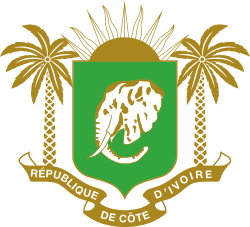
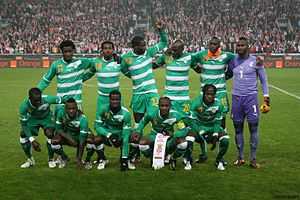
.svg.png)
.svg.png)
